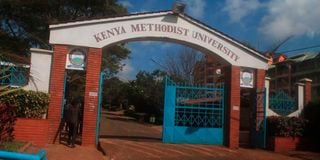Select private universities gobble up government allocations

Kenya Methodist University in Meru. It has received Sh218,994,044 from the government town.
Private universities have received a total of Sh13.75 billion from the time the government started placing students in the institutions five years ago.
Some private universities have been getting more money than public institutions that are saddled with debts and many struggling to remain financially afloat, Higher Education can reveal.
The private entities have been gobbling up public universities’ lunch through the programme that was started in 2018 for them to admit students, with the government subsidising tuition fee.
The flow of the funding has been less than adequate and as a result, the government now owes private universities Sh15.27 billion, according to data from the Universities Fund (UF).
Public university vice-chancellors have for long vehemently opposed the plan, arguing that they have capacity to accommodate all government-sponsored students (GSS).
The number of GSS in private universities has risen from 29,729 in the 2018/19 academic year to 93,773. Public universities have 356,188 such learners.
In the 2021/2022 allocation by the UF, thirty one private universities received close to Sh3.4 billion out of which Sh2 billion went to just five of the institutions.
Mt Kenya University (MKU) tops the list of beneficiaries of the programme, which is to come to an end if proposals to halt it are implemented. In the allocation MKU received Sh787.4 million for the GSS while 20 public universities got less that amount.
Other private universities that received huge allocations are Kabarak (Sh404,998,513), KCA (Sh299,247,672), Catholic University of East Africa (Sh259,566,606) and Kenya Methodist (Sh218,994,044).
The UF disburses money to institutions of higher learning using the differentiated unit cost (DUC), whose calculations are based on particular courses.
This is determined by among others, the staff cost, staff-student ratio, number of learners, cost of infrastructure and equipment as well as the level of the programme.
Excluding university colleges, Kirinyaga University had the least allocation of Sh358,634,303, followed by Taita Taveta University (Sh404,458,366).
Others are Garissa University (Sh417,371,564) and Murang’a and Bondo (Sh576,353,490 each).
At Sh5,588,025,893, the University of Nairobi received the highest amount, followed by Moi at Sh3,424,222,563.
The National Assembly Public Investments Committee on Education and Governance (PICEG) has proposed changes to the Universities Act to halt the sending of GSS to private universities.
“Students who willingly choose private education must surely be capable of funding the same,” PICEG chairman Wanami Wamboka said in a statement to the House.
During a recent meeting of the committee with Higher Education and Research Principal Secretary, Beatrice Inyangala, the MPs called for a special audit of the cash disbursed to private universities in the last five financial years.
“Should we allow public money to go to private universities? This committee should take bold step and stop public money from going to private institutions until they are audited. We could be sitting here as money is getting lost,” Embakasi West MP Mark Mwenje said.
Dr Inyangala, however, defended the placement of students to private universities saying no extra fee is charged.
“When it comes to fees, we have negotiated with private universities not to charge more. If they charge any additional money, it is illegal,” the PS told the lawmakers.
She added that the amended University Act, 2012 allowed the government to place students in any university.
“We may not be able to stop placement to private universities because our hands are tied by the law. Any decision not based on law will attract litigation,” Dr Inyangala said.
It is also widely expected that the Presidential Working Party on Education Reforms (PWPER), whose term ended last week, will recommend changes to the placement criteria.
The Kenya Universities and Colleges Central Placement Service (KUCCPS) has put on hold the placement of the more than 173,000 learners who qualified for university admission after the 2022 Kenya Certificate of Secondary Education examination awaiting the recommendations of the PWPER report and adoption.
It is widely expected that fewer students will get government sponsorship this year as opposed to the current scenario where anyone who scores the minimum university entry grade of C+ (plus) qualifies to get the money.
However, the criterion of determining who gets the sponsorship is the elephant in the room.
In a memorandum to the PWPER, the National Association of Private Universities in Kenya proposed that the KUCCPS places students, based on available funds and DUC as determined by the UF.
“Government sponsorship for university education should be formulated on the basis of deserving cases, affirmative action and in support of government national development agenda,” reads the memorandum.
The Prof Raphael Munavu-led PWPER is expected to present its report to President William Ruto.
Some members of the team were pushing for additional time but by the time of going to press, there was no information on that.





